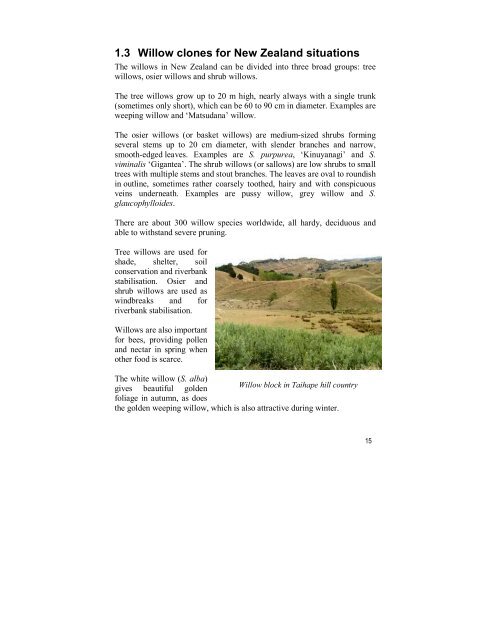Growing Poplar and Willow Trees on Farms, National - FAO
Growing Poplar and Willow Trees on Farms, National - FAO
Growing Poplar and Willow Trees on Farms, National - FAO
You also want an ePaper? Increase the reach of your titles
YUMPU automatically turns print PDFs into web optimized ePapers that Google loves.
1.3 <str<strong>on</strong>g>Willow</str<strong>on</strong>g> cl<strong>on</strong>es for New Zeal<str<strong>on</strong>g>and</str<strong>on</strong>g> situati<strong>on</strong>s<br />
The willows in New Zeal<str<strong>on</strong>g>and</str<strong>on</strong>g> can be divided into three broad groups: tree<br />
willows, osier willows <str<strong>on</strong>g>and</str<strong>on</strong>g> shrub willows.<br />
The tree willows grow up to 20 m high, nearly always with a single trunk<br />
(sometimes <strong>on</strong>ly short), which can be 60 to 90 cm in diameter. Examples are<br />
weeping willow <str<strong>on</strong>g>and</str<strong>on</strong>g> ‘Matsudana’ willow.<br />
The osier willows (or basket willows) are medium-sized shrubs forming<br />
several stems up to 20 cm diameter, with slender branches <str<strong>on</strong>g>and</str<strong>on</strong>g> narrow,<br />
smooth-edged leaves. Examples are S. purpurea, ‘Kinuyanagi’ <str<strong>on</strong>g>and</str<strong>on</strong>g> S.<br />
viminalis ‘Gigantea’. The shrub willows (or sallows) are low shrubs to small<br />
trees with multiple stems <str<strong>on</strong>g>and</str<strong>on</strong>g> stout branches. The leaves are oval to roundish<br />
in outline, sometimes rather coarsely toothed, hairy <str<strong>on</strong>g>and</str<strong>on</strong>g> with c<strong>on</strong>spicuous<br />
veins underneath. Examples are pussy willow, grey willow <str<strong>on</strong>g>and</str<strong>on</strong>g> S.<br />
glaucophylloides.<br />
There are about 300 willow species worldwide, all hardy, deciduous <str<strong>on</strong>g>and</str<strong>on</strong>g><br />
able to withst<str<strong>on</strong>g>and</str<strong>on</strong>g> severe pruning.<br />
Tree willows are used for<br />
shade, shelter, soil<br />
c<strong>on</strong>servati<strong>on</strong> <str<strong>on</strong>g>and</str<strong>on</strong>g> riverbank<br />
stabilisati<strong>on</strong>. Osier <str<strong>on</strong>g>and</str<strong>on</strong>g><br />
shrub willows are used as<br />
windbreaks <str<strong>on</strong>g>and</str<strong>on</strong>g> for<br />
riverbank stabilisati<strong>on</strong>.<br />
<str<strong>on</strong>g>Willow</str<strong>on</strong>g>s are also important<br />
for bees, providing pollen<br />
<str<strong>on</strong>g>and</str<strong>on</strong>g> nectar in spring when<br />
other food is scarce.<br />
The white willow (S. alba)<br />
gives beautiful golden<br />
<str<strong>on</strong>g>Willow</str<strong>on</strong>g> block in Taihape hill country<br />
foliage in autumn, as does<br />
the golden weeping willow, which is also attractive during winter.<br />
15

















